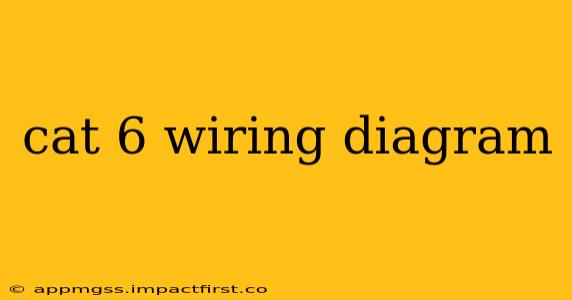Cat 6 cabling is the backbone of many high-speed networks, offering superior performance compared to older standards like Cat 5e. Understanding how to correctly wire a Cat 6 cable is crucial for achieving optimal network speeds and reliability. This guide provides a detailed explanation of Cat 6 wiring diagrams, addressing common questions and concerns.
What is a Cat 6 Cable?
Before diving into wiring diagrams, let's clarify what Cat 6 is. Category 6 (Cat 6) cabling is a twisted-pair Ethernet cable designed to support Gigabit Ethernet and beyond. Its improved specifications, including tighter twists and better shielding, allow for higher bandwidth and longer cable runs compared to Cat 5e. This makes it ideal for applications demanding high data transfer rates, such as HD video streaming, online gaming, and large file transfers.
Common Cat 6 Wiring Standards: T568A and T568B
The two most prevalent wiring standards for Cat 6 cables are T568A and T568B. While both standards achieve the same functionality, the color arrangement of the wires differs. Consistency is key: It's crucial to use the same standard at both ends of the cable. Mixing T568A and T568B will result in a non-functional connection.
T568A Wiring Diagram:
| Wire Pair | Color | Pin Number |
|---|---|---|
| Pair 1 | Green/White | 1 |
| Pair 1 | Green | 2 |
| Pair 2 | Orange/White | 3 |
| Pair 2 | Orange | 4 |
| Pair 3 | Blue/White | 5 |
| Pair 3 | Blue | 6 |
| Pair 4 | Brown/White | 7 |
| Pair 4 | Brown | 8 |
T568B Wiring Diagram:
| Wire Pair | Color | Pin Number |
|---|---|---|
| Pair 2 | Orange/White | 1 |
| Pair 2 | Orange | 2 |
| Pair 1 | Green/White | 3 |
| Pair 1 | Green | 4 |
| Pair 3 | Blue/White | 5 |
| Pair 3 | Blue | 6 |
| Pair 4 | Brown/White | 7 |
| Pair 4 | Brown | 8 |
Notice that pairs 3 and 4 are identical in both standards.
Why Use a Specific Wiring Standard?
Using a consistent wiring standard throughout your network ensures compatibility and simplifies troubleshooting. While either T568A or T568B will work, choosing one and sticking with it is best practice. Many network technicians prefer T568B, but the choice is ultimately arbitrary as long as it remains consistent.
How to Wire a Cat 6 Cable: A Step-by-Step Guide
Wiring a Cat 6 cable requires precision and attention to detail. While a detailed, step-by-step visual guide is beyond the scope of this text-based format, numerous high-quality video tutorials are readily available on platforms like YouTube. Searching for "how to crimp Cat 6 cable" will yield excellent results. Remember to use the correct crimping tool and Cat 6 connectors for optimal performance.
Troubleshooting Cat 6 Cabling Issues
If your network is experiencing connectivity problems, incorrect Cat 6 wiring could be the culprit. Common issues include:
- No connectivity: This often points to incorrect wiring, damaged cables, or faulty connectors.
- Intermittent connectivity: This suggests loose connections or poor cable quality.
- Slow speeds: This might indicate a problem with the wiring, but other factors like network congestion or device limitations should also be investigated.
Using a cable tester can help identify faulty wiring quickly.
What is the difference between Cat 5e and Cat 6 cabling?
Cat 6 cables offer improved performance over Cat 5e cables, primarily due to enhanced specifications that allow for higher bandwidth and longer cable runs at higher speeds. Cat 5e is suitable for Gigabit Ethernet, but Cat 6 provides better signal integrity, making it preferable for demanding applications and future-proofing your network. The physical differences include tighter twists in the wire pairs and often, improved shielding.
Can I use Cat 6 connectors on Cat 5e cables?
While you can physically attach Cat 6 connectors to Cat 5e cables, it's not recommended. The connectors are designed for the specific cable type, and using mismatched components can compromise the performance and reliability of the connection, potentially leading to network issues.
This guide provides a solid foundation for understanding Cat 6 wiring diagrams and best practices. Remember to consult reliable video tutorials for a visual, step-by-step approach to cabling. Properly wired Cat 6 cables are essential for a fast and reliable network.
